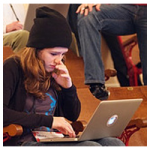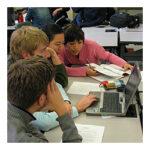‘Teaching Guide’
Newly Updated Teaching Guide: Personal Devices in the Classroom
Dec. 16, 2021—The CFT first published a guide on considering how to work with wireless devices in the classroom in 2010. Given the rapidly changing digital landscape since then, this guide has been updated to consider how personal electronic devices (especially laptops) can impact learning in the classroom, and how faculty members may design policies and positions regarding their usage. ...
New Guide on Project-based and Dynamic Collaborative Learning
Nov. 25, 2021—The newest addition to the CFT’s Course Development Resources (CDR) site, entitled Project-Based and Dynamic Collaborative Learning, is all about how instructors can design meaningful, effective group work through research-informed strategies and the intentional use of technology. The guide explores the research on collaborative groups and answers questions such as: How should we form groups? How can we effectively...
Promoting Persistence in STEM Learning Community: Resources and Reflections
Sep. 28, 2021—STEM disciplines have long been concerned with disparities between underrepresented and well-represented student groups and the associated “pipeline” problem, where underrepresented students are more likely to switch away from STEM majors. In 2020-2021, a group of about twenty faculty from eight departments met biweekly to consider ways to address this problem individually and collectively. Members...
New CFT Guide on Academic Advising
Feb. 22, 2021—The CFT is proud to offer a new teaching guide on academic advising. Academic advising is a foundational element of any institution of higher education because it is necessary for student achievement. However, it can be difficult to do well, especially when time is limited or advising models are unclear. In this guide, the CFT’s...
Updated Teaching Guide on Motivating Students
Nov. 19, 2020—One of our most popular teaching guides on the Center for Teaching website is on motivating students. Thanks to the work of Chelsea Yarborough, former Graduate Teaching Fellow, and Heather Fedesco, Assistant Director, the guide has been updated to reflect three popular student motivation theories and models. You can learn more about the Expectancy-Value-Cost model,...
New CFT Guide on Assessing Student Learning Now Available
Dec. 18, 2019—Student assessment is, arguably, the centerpiece of the teaching and learning process and therefore the subject of much discussion in the scholarship of teaching and learning. Without some method of obtaining and analyzing evidence of student learning, we can never know whether our teaching is making a difference. That is, teaching requires some process through...
Workshop Collaboration Leads to New CFT Teaching Guide: Developing and Writing a Diversity Statement
Jun. 18, 2018—In April, The Vanderbilt Center for Teaching partnered with The Office of Inclusive Excellence and The Office for Career Development at The Graduate School to provide an introductory workshop on developing a written diversity statement. The session was facilitated by Graduate Teaching Fellow Sara Beck and CFT Assistant Director Joe Bandy and featured a Q&A...
Rethinking the Presentation of the Teaching Guide
Feb. 11, 2018—by Ryan Bowen, CFT Graduate Assistant When we try a new teaching approach, we may have a sense that there is research that can help us make choices about how to implement it. Often, however, it can be a challenge to find that research. What journals is it found in? What are the right terms...
Newly Revised CFT Guide on Course Design
Jun. 5, 2017—The Understanding by Design teaching guide was recently updated by Ryan Bowen, a graduate teaching fellow at the Center for Teaching. Understanding by Design is a book written by Grant Wiggins and Jay McTighe that offers a framework for designing courses, content units, and lessons. The teaching guide walks readers through “backward design” which is...
New CFT Teaching Guide – Leveraging Study Abroad: Collecting and Teaching with Authentic Resources
Aug. 24, 2016—By Stacey M. Johnson and Vivian Finch, CFT Assistant Directors In language classrooms, instructors often bring in authentic language and culture resources for students to examine. These resources help students to gain a perspective on how people use language in culturally situated ways. For many students, contact with authentic resources is one of the most...










